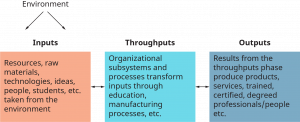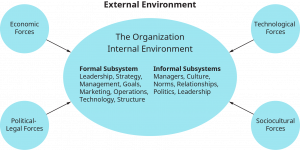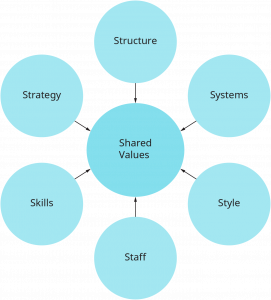2.4 The Internal Organization and External Environments
4. Explain how organizations organize to meet external market threats and opportunities.
At a basic level of understanding how internal organizations respond to environments, consider the theory of Open Systems, which the organizational theorists Katz and Kahn35 and Bertalanffy introduced.
Exhibit 2.11 illustrates this theory’s view of organizations as open systems that take in resources and raw materials at the “input” phase from the environment in a number of forms, depending on the nature of the organization, industry, and its business. Whatever the input resource, (information, raw materials, students entering a university), those resources will be transformed by the internal processes of the organization. The internal organizational systems then process and transform the input material, which is called “through-put” phase, and move the changed material (resources) to the “outputs” and back into the environment as products, services, graduates, etc.

Exhibit 2.11 Open System Model of an Organization (Attribution: Copyright Rice University, OpenStax, under CC-BY 4.0 license)
The open systems model serves as a feedback loop continually taking in resources from the environment, processing and transforming them into outputs that are returned to the environment. This model explains organizational survival that emphasizes long-term goals.
Organizations according to this theory are considered as either Open or Closed systems, (or relatively opened or closed) depending on the organization’s sensitivity to the environment. Closed systems are less sensitive to environmental resources and possibilities, and open systems are more responsive and adaptive to environmental changes. For example, during the 1980’s the then Big 3 U.S. auto manufacturers (Ford, General Motors and Chrysler) were pressured by Japanese auto manufacturers’ successful 4-cylinder car sales that hit the U.S. like a shock wave. The Detroit producers experienced slumping sales, plant closures, and employee lay-offs in response to the Japanese wave of competition. It seemed that the U.S. auto makers had become closed or at least insensitive to changing trends in cars during that time and were unwilling to change manufacturing processes. Similarly, Amazon’s business model, discussed earlier, has and continues to pressure retailers to innovate and change processes and practices to compete in this digital era.
Organizations respond to external environments not only through their structures, but also by the domains they choose and the internal dimensions and capabilities they select. An organization defines itself and its niche in an environment by the choice of its domain, i.e., what sector or field of the environment it will use its technology, products, and services to compete in and serve. Some of the major sectors of a task environment include marketing, technology, government, financial resources, and human resources.
Presently, several environmental domains that once were considered stable have become more complex and unstable—e.g., toys, public utilities, the U.S. Postal Service, and higher education. And even domains are changing. For example, as referred to earlier, the traditionally stable and somewhat unchanging domain of higher education has become more complex with the entry of for-profit educational institutions, MOOCs (massive open online courses), internal company “universities,” and other certification and degree programs outside traditional private institutions. Sharing-economy companies such as Uber and Airbnb have redefined the transportation domain in which taxis operate and the hospitality domain in which hotels and bed and breakfasts serve. New business models that use mobile phones, ICTs (information communication technologies), and apps remove middle management layers in traditional organizations and structures.
With a chosen domain in which to operate, owners and leaders must organize internal dimensions to compete in and serve their markets. For example, hierarchies of authority and chain of command are used by owners and top-level leaders to develop and implement strategic and enterprise decisions; managers are required to provide technologies, training, accounting, legal, and other infrastructure resources; and cultures still count to establish and maintain norms, relationships, legal and ethical practices, and the reputation of organizations.

Exhibit 2.12 Internal Organization (Attribution: Copyright Rice University, OpenStax, under CC-BY 4.0 license)
Exhibit 2.12 shows internal organizational dimensions. These dimensions and systems include leadership, strategy, culture, management, goals, marketing, operations, and structure. Relationships, norms, and politics are also included in the informal organization. There are other internal functions not listed here, such as research and development, accounting and finance, production, and human resources. Another popular depiction of internal organizational dimensions is the McKinsey 7-S model, shown in Exhibit 2.13. Similarly, strategy, structure, systems, skills, staff, and style all revolve around and are interconnected with shared values (or culture) in an organization.

Exhibit 2.13 The McKinsey 7-S Model (Attribution: Copyright Rice University, OpenStax, under CC-BY 4.0 license)
A unifying framework shown in Exhibit 2.14, developed by Arie Lewin and Carroll Stephens,37 illustrates the integration of internal organizational dimensions and how these work in practice to align with the external environment. Note that it is the CEO and other top-level leaders who scan the external environment to identify uncertainties and resources before using a SWOT analysis (identifying strengths, weaknesses, opportunities, and threats) to confirm and update the domain of an organization and then to define the vision, mission, goals, and strategies. Once the enterprise goals and strategies are developed, the organizational culture, structure, and other systems and policies can be established (human resources, technologies, accounting and finance, and so on).

Exhibit 2.14 The Internal Organization and External Environment (Attribution: Copyright Rice University, OpenStax, under CC-BY 4.0 license)
As Exhibit 2.14 shows, after a CEO and the top-level team identify opportunities and threats in the environment, they then determine the domain and purpose of the organization from which strategies, organizational capabilities, resources, and management systems must be mobilized to support the enterprise’s purpose.38 The company McDonald’s has, for example, successfully aligned its enterprise with the global environments it serves, which is “1% of the world’s population—more than 70 million customers—every day and in virtually every country across the world.” The major operating goal of the firm driving its internal alignment is a “fanatical attention to the design and management of scalable processes, routines, and a working culture by which simple, stand-alone, and standardized products are sold globally at a predictable, and therefore manageable, volume, quality, and cost.”39 A more detailed SWOT analysis of McDonald’s operations can be found in endnote.
In practice, no internal organizational alignment with its external environment is perfect or permanent. Quite the opposite. Companies and organizations change leadership and strategies and make structural and systems changes to meet changing competition, market forces, and customers and end users’ needs and demands. Even Amazon continues to develop, expand, and change. With a mission statement as bold and broad as Amazon’s, change is a constant: “Our vision is to be earth’s most customer-centric company; to build a place where people can come to find and discover anything they might want to buy online” (Amazon.com, Apr 15, 2018).
Amazon has a functional organizational structure that focuses on business functions for determining the interactions among the different parts of the company. Amazon’s corporate structure is best characterized as global function-based groups (most significant feature), a global hierarchy, and geographic divisions, as Exhibit 2.14 shows. This structure seems to fit with the size of Amazon’s business—43% of 2016 retail sales were in the United States.40 Seven segments, including information technology, human resources and legal operations, and heads of segments, report to Amazon’s CEO. “Senior management team include two CEOs, three Senior Vice Presidents and one Worldwide Controller, who are responsible for various vital aspects of the business reporting directly to Amazon CEO Jeff Bezos.” The strategic goal underlying this structure is to facilitate Amazon.com to successfully implement e-commerce operations management throughout the entire organization.

Exhibit 2.15 Amazon’s Corporate Structure (Attribution: Copyright Rice University, OpenStax, under CC-BY 4.0 license)
Despite the company’s exponential growth and success to date, as noted earlier in the section on organizational structures, a disadvantage of structures such as Amazon’s, and in this case Amazon’s, is that it has limited flexibility and responsiveness even with its current growth. “The dominance of the global function-based groups and global hierarchy characteristics reduces the capacity of Amazon to rapidly respond to new issues and problems encountered in the e-commerce business.” Still, Amazon’s most outstanding success factor remains its CEO, Jeff Bezos—his ingenuity, vision and foresight, and ability to sustain and even extend the company’s competitive advantages. Amazon customers value these factors—customer purchase criteria (CPC) that include price, fast delivery, and reliable service. “Consumers choose Amazon because it does better than its competition on these CPC.”
CONCEPT CHECK
1. Identify the six major organizational structures.
2. Explain the McKinsey 7-S model.
Source contents: Principles of Management and Organizational Behavior. Please visit OpenStax for more details: https://openstax.org/subjects/view-all

